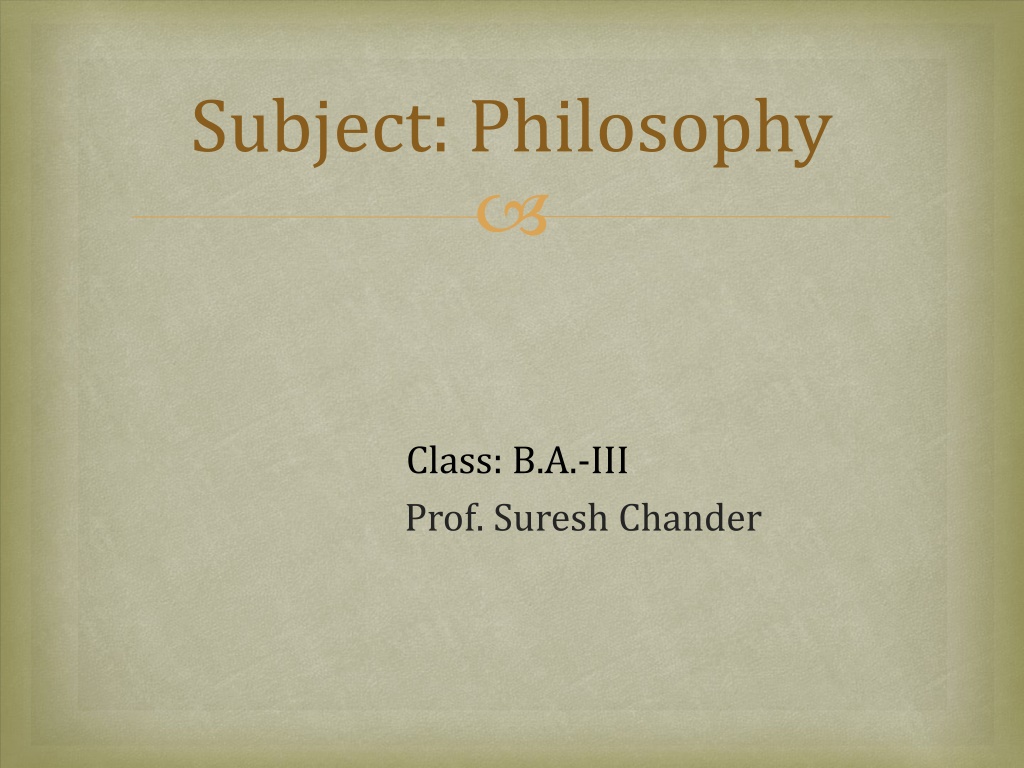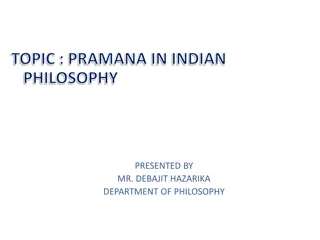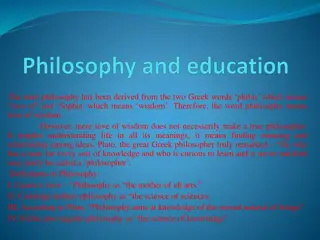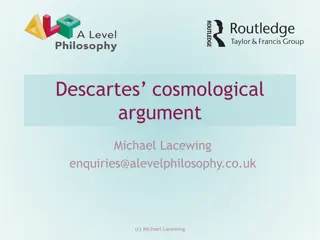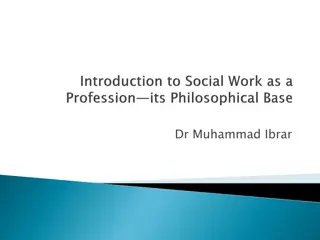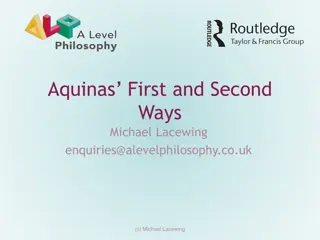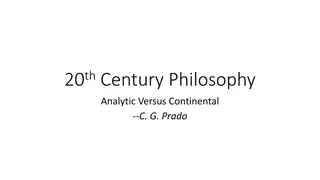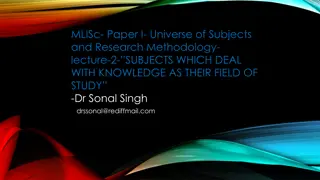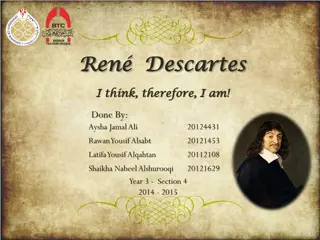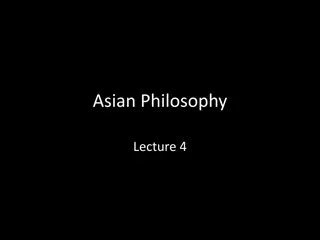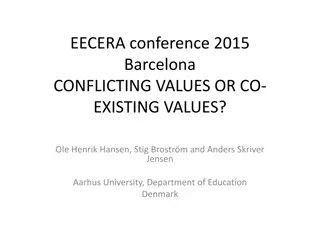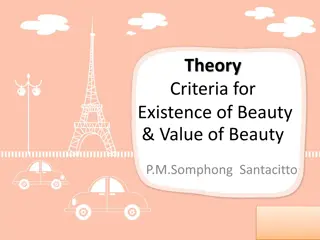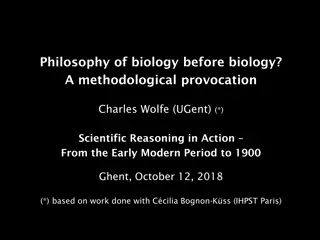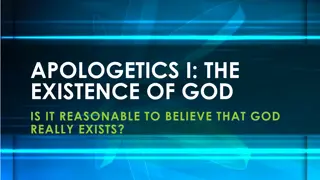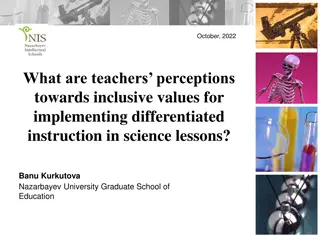Philosophy: Study of Existence, Knowledge, Values
Philosophy, originating from Greek roots meaning "love" and "wisdom," delves into fundamental questions about existence, knowledge, values, reason, mind, and language. It encompasses three main areas: metaphysics, epistemology, and axiology. Metaphysics focuses on the nature of existence, while epistemology examines the nature of knowledge. Philosophy is a systematic approach to understanding life's meaning, truth, and reality, embodying open-mindedness and serving as the oldest discipline of thought.
Download Presentation

Please find below an Image/Link to download the presentation.
The content on the website is provided AS IS for your information and personal use only. It may not be sold, licensed, or shared on other websites without obtaining consent from the author.If you encounter any issues during the download, it is possible that the publisher has removed the file from their server.
You are allowed to download the files provided on this website for personal or commercial use, subject to the condition that they are used lawfully. All files are the property of their respective owners.
The content on the website is provided AS IS for your information and personal use only. It may not be sold, licensed, or shared on other websites without obtaining consent from the author.
E N D
Presentation Transcript
Subject: Philosophy Class: B.A.-III Prof. Suresh Chander
Philosophy The original meaning of the word philosophy comes from the Greek roots Philo- meaning "love" and -Sophia, or "wisdom." When someone studies philosophy they want to understand how and why people do certain things and how to live a good life. In other words, they want to know the meaning of life. Philosophy is the study of general and fundamental questions about existence, knowledge, values, reason, mind, and language. Such questions are often posed as problems to be studied or resolved. Three main areas of philosophy: metaphysics, epistemology and Axiology. Characteristics of Philosophy: It is a living force. Open mindedness. ... It is the oldest and original discipline of thoughts. It is a search for truth and reality. It is a systematic approach showing connections between different parts of beliefs or thoughts systems. It is a way of life.
Metaphysics Metaphysics is the branch of philosophy concerned with the nature of existence, being and the world. Arguably, metaphysics is the foundation of philosophy. Aristotle originally split his metaphysics into three main sections and these remain the main branches of metaphysics: Ontology (the study of being and existence, including the definition and classification of entities, physical or mental, the nature of their properties, and the nature of change) Natural Theology (the study of God, including the nature of religion and the world, existence of the divine, questions about the creation, and the various other religious or spiritual issues) Universal Science (the study of first principles of logic and reasoning, such as the law of non-contradiction) Metaphysics has been attacked, at different times in history, as being futile and overly vague, particularly by David Hume, Immanuel Kant and A. J. Ayer. It may be more useful to say that a metaphysical statement usually implies an idea about the world or the universe, which may seem reasonable but is ultimately not empirically verifiable, testable or provable.
Epistemology Epistemology is the study of the nature and scope of knowledge and justified belief. It analyses the nature of knowledge and how it relates to similar notions such as truth, belief and justification. It also deals with the means of production of knowledge, as well as scepticism about different knowledge claims. It is essentially about issues having to do with the creation and dissemination of knowledge in particular areas of inquiry. Epistemology asks questions like: "What is knowledge?", "How is knowledge acquired?", "What do people know?", "What are the necessary and sufficient conditions of knowledge?", "What is its structure, and what are its limits?", "What makes justified beliefs justified?", "How we are to understand the concept of justification?", "Is What is Knowledge? Knowledge is the awareness and understanding of particular aspects of reality. It is the clear, lucid information gained through the process of reason applied to reality. The traditional approach is that knowledge requires three necessary and sufficient conditions, so that knowledge can then be defined as "justified true belief".
Materialism Materialism is a form of philosophical monism that holds that matter is the fundamental substance in nature, and that all things, including mental states and consciousness, are results of material interactions. Materialism holds that the only thing that can be truly proven to exist is matter. Thus, according to Materialism, all things are composed of material and all phenomena are the result of material interactions, with no accounting of spirit or consciousness. As well as a general concept in metaphysics, it is more specifically applied to the mind-body problem in Philosophy of Mind. In common use, the word "materialist" refers to a person for whom collecting material goods is an important priority, or who primarily pursues wealth and luxury or otherwise displays conspicuous consumption. This can be more accurately termed Economic Materialism. Ancient Greek philosophers like Thales, Parmenides, Anaxagoras, Democritus, and then, later, Epicurus and Lucretius (99 - 55 B.C.) all prefigure later materialists, and contributed towards the classic formulation of Materialism. Lucretius wrote "De Rerum Natura" ("The Nature of Things"), the first masterpiece of materialist literature, around 50 B.C.
Types of Materialism The various types of reductive and non-reductive Physicalism are discussed in that section, but there are some other related concepts which can be mentioned briefly here: Dialectical Materialism is the philosophical basis of Marxism and Communism. The term, which was never actually used by Marx himself, refers to the notion of a synthesis of Georg Hegel s theory of Dialectics (the concept that any idea or event - the thesis - generates its opposite - the antithesis - eventually leading to a reconciliation of opposites - a new, more advanced synthesis) and Materialism (in the respect that Dialectics could also be applied to material matters like economics). The application of the principle of Dialectical Materialism to history and sociology, the main context in which Marx used it, is known as Historical Materialism (see below). Historical Materialism (or the "materialist conception of history") is the Marxist methodological approach to the study of society, economics and history which was first articulated by Karl Marx and Friedrich Engels (1820 - 1895), and has been expanded and refined by many academic studies since. It is essentially the application of the principle of Dialectical Materialism (see above) to history and sociology. According to Marx, for human beings to survive, they need to produce and reproduce the material requirements of life, and this production is carried out through a division of labour based on very definite production relations between people. These relations form the economic base of society, and are themselves determined by the mode of production which is in force (e.g. tribal society, ancient society, feudalism, capitalism, socialism), and societies, and their cultural and institutional superstructures, naturally move from stage to stage when the dominant class is displaced by a new emerging class in a social and political upheaval. Although Marx himself said that he was only proposing a guideline for historical research, by the 20th Century the concept of Historical Materialism had become a keystone of modern Communist doctrine.
Types of Materialism Dialectical Materialism is the philosophical basis of Marxism and Communism. The term, which was never actually used by Marx himself, refers to the notion of a synthesis of Georg Hegel s theory of Dialectics and Materialism. The application of the principle of Dialectical Materialism to history and sociology, the main context in which Marx used it, is known as Historical Materialism. Historical Materialism is the Marxist methodological approach to the study of society, economics and history which was first articulated by Karl Marx and Friedrich Engels, and has been expanded and refined by many academic studies since. It is essentially the application of the principle of Dialectical Materialism to history and sociology. According to Marx, for human beings to survive, they need to produce and reproduce the material requirements of life, and this production is carried out through a division of labour based on very definite production relations between people. These relations form the economic base of society, and are themselves determined by the mode of production which is in force, and societies, and their cultural and institutional superstructures, naturally move from stage to stage when the dominant class is displaced by a new emerging class in a social and political upheaval. Although Marx himself said that he was only proposing a guideline for historical research, by the 20th Century the concept of Historical Materialism had become a keystone of modern Communist doctrine.
Characteristics Mechanical materialism is the theory that the world consists entirely of hard, massy material objects, which, though perhaps imperceptibly small, are otherwise like such things as stones. Materialism gets a bad press. There is an assumption that people who prioritise things are inherently selfish. Highly materialistic people believe that owning and buying things are necessary means to achieve important life goals, such as happiness, success and desirability. But other research shows that materialism is a natural part of being human and that people develop materialistic tendencies as an adaptive response to cope with situations. Underlying desires Materialism is not only found in particularly materialistic people. Even referring people as customer, as opposed to using other generic terms such as citizens, can temporarily activate a materialistic mindset. Telling people to be less materialistic is like telling people that they shouldn t enjoy sex or eat fatty foods. People can learn to control their impulses, but this does not remove the underlying desires.
The caring materialists Our research examined how materialism is perceived across cultures and it revealed that there is more to materialism than just self-gratification Buying aspirational brands of goods and services is a common approach in the gift-giving traditions in East Asia. We also found that materialists in general are meaning- seekers rather than status seekers. They believe in the symbolic and signalling powers of products, brands and price tags.
Reconciling material So how do we get an increasingly materialistic society to care more about the greater good and be less conspicuous and wasteful in its consumption? The answer is to look to our culture and what sort of collectivistic values it tries to teach us. We found that a simple reminder of the community value that resonates with who we are as a society can help reduce materialistic tendencies. Social marketers and public policymakers should tap into society s materialistic tendencies to promote well-meaning social programmes, such as refugee settlement, financial literacy programmes and food bank donations. A perfect example is the choose love charity pop-up store in central London, where people get to purchase real products in a beautifully designed retail space akin to the Apple store, which are then distributed to refugees in Greece, Iraq and Syria. Materialism undoubtedly has an ugly face but it is here to stay. Rather than focusing efforts to diminish it, individual consumers, businesses and policymakers should focus on using it for promoting collective interests that benefit wider society.
Principles of Idealism 1. Idealism Believes in the Universal Mind: Besides the physical or material universe, there is also a spiritual universe which is permeated by the Universal Mind of God. He is the Creator and others are the created. Human mind is a part of the Universal Mind and is dependent of Him. God or the Universal Mind is the source of all human values and the goal of all human activities is the realization of this Universal Mind is one s own self. 2. Idealism Regards Man as a Spiritual Being: Idealism believes that man is a mere animal. He is essentially a spiritual being whose chief aim is to develop his spiritual nature. It is this spirituality that distinguishes man from other lower creatures. 3. The World of Ideas and Values is more important than the world of Matter: Idealism has full faith in eternal values which never change. They can neither be created nor destroyed. According to Plato, the outstanding eternal values are Truth, Goodness and Beauty.
Cont. 4. Real knowledge is perceived in mind: The knowledge which is gained through the activity of mind is more important than the knowledge, acquired through senses. 5. Stress on the Principle of Unity of Diversity: Idealists stress on the Principle of Unity in Diversity. They believe that implicit in all the diversities is an essential unity. Prof. H. N. Home says, An idealistic philosophy of education, then, is an account of man finding himself as an integral part of universe mind. 6. Importance of Personality Development: Idealists give very importance to the Self of the individual. Hence they insist upon the fullest development of the personality of an individual. The development of personality means achievement of perfection.
Criticism Obviously, some of the types of idealism in the above classifications conflict with one another. The famous Refutation of Idealism prepared by the meticulous Cambridge philosopher G. E. Moore and a similar refutation by Russell rest upon the distinction between a subject s act of perceiving and the perceptual object of this act, which they both called a sense datum. Idealists considered all of the foregoing criticisms to be external. Instead of answering them in detail, some idealists preferred to challenge the critics to make genuinely constructive efforts to build an adequate substitute for idealism a system to be reached by seriously working at the problems from within philosophy. Although it is now on the wane, at least in Western culture, the great idealist tradition has survived many other historical periods of turmoil and has often been reborn in prolonged periods of settled and peaceful social conditions.
Nature of Knowledge 1. Teaching is a highly complex occupation, which needs to adapt to a great deal of variety in context, subject matter and learners. It does not lend itself to broad generalizations. 2. Our underlying beliefs and values, usually shared by other experts in a subject domain, shape our approach to teaching. These underlying beliefs and values are often implicit and are often not directly shared with our students, even though they are seen as essential components of becoming an expert in a particular subject domain. 3. Different theories of learning reflect different views on the nature of knowledge. 4. Every teacher starts from some epistemological or theoretical position, even if it is not explicit, or even if the teacher is not fully aware of their beliefs. 5. With the possible exception of connectivism, there is some form of empirical evidence to support each of the theories of learning outlined here. 6. It is argued that academic knowledge is different from other forms of knowledge, and is even more relevant today in a digital age. 7. However, academic knowledge is not the only kind of knowledge that is important in today s society, and as teachers we have to be aware of other forms of knowledge and their potential importance to our students, and make sure that we are providing the full range of contents and skills needed for students in a digital age.
Knowing the Subject Teachers should know their subject matter thoroughly, but it is impossible for one person to know any subject completely. Teachers are always traveling toward complete knowledge but never arriving. Of course, every person follows the same road, whether he notices or not. It's a good road to travel though, always fresh and challenging. Every day we can stretch again to reach a noble goal. We meet people with vast stores of knowledge: computer technicians, doctors, financial planners, mortgage bankers, housing inspectors, auto mechanics. Some speak in a jargon so dense we struggle to grasp a fraction of what they say. Everyone is unaware of something cheesecake recipes, quantum physics, properties of tanzanite. When the photocopy process was first developed, businesses were unaware of its useful value; the inventor leased machines to offices to create awareness. With hindsight the value seems clear, yet we surely remain blind to certain things that will someday be obvious.
Cont. Novices begin with much to learn. Although they have completed the education department's coursework, they are still wet behind the ears because there are thousands of facts and nuances that can be mastered only through experience. Incomplete knowledge is the normal state of the beginner. Beginners rarely check to see what students already know. Novice teachers often follow a plan developed by someone else usually a textbook or a prescribed curriculum. Such outlines imply that the information must be covered in the order in which it's presented, so novices plunge forward. It may take months to notice that many students already know the material or that some lack the background information needed for full comprehension.
Act of knowing Acts of Knowing aims to provide readers with a means of understanding the issues from the perspective of Critical Pedagogy; an educational philosophy which believes that 'knowing' must be freed from the constraints of the financial and managerialism logics which dominate the contemporary university. Critical Pedagogy is important for three key reasons: it conceptualises pedagogy as a process of engagement between the teacher and taught; secondly that that engagement is based on an underlying humanistic view about human worth and value; and thirdly that the 'knowing' which can come out of this engagement needs to be understood essentially as exchange between people, rather than a financial exchange. It distinguishes the four standard basic sources : perception, memory, consciousness, and reason. A basic source yields knowledge or justified belief without positive dependence on another source.
Sources of knowledge What is Knowledge? Ways/Source of Acquiring Knowledge. Sensory Perception. Logical Reasoning. Deductive Reasoning. Categorical Syllogism. Major Premise: it is a self-evident assumption, previously established by metaphysical truth or dogmas. ...
Objects of knowledge "Objects of knowledge" is a term of art and must be treated as a unit. Forgive the oversimplification, but in Plato's philosophy, there's a world of being and a world of Becoming. ... The things in the world of being are objects of knowledge; those in the world of Becoming are objects of opinion or perception. The object of knowledge involves the consciousness of the distinction between the idea of an object and the object that warrants. The idea, - a distinction without which there would be no knowledge and which carries in its train all the perplexing questions as.
The Coherence Theory A coherence theory of truth states that the truth of any (true) proposition consists in its coherence with some specified set of propositions. The coherence theory differs from its principal competitor, the correspondence theory of truth, in two essential respects. The competing theories give conflicting accounts of the relation that propositions bear to their truth conditions. The coherence theory of truth has several versions. These versions differ on two major issues. Different versions of the theory give different accounts of the coherence relation. Different varieties of the theory also give various accounts of the set (or sets) of propositions with which true propositions cohere. According to some early versions of the coherence theory, the coherence relation is simply consistency. On this view, to say that a proposition coheres with a specified set of propositions is to say that the proposition is consistent with the set.
Cont. A more plausible version of the coherence theory states that the coherence relation is some form of entailment. Entailment can be understood here as strict logical entailment, or entailment in some looser sense. According to this version, a proposition coheres with a set of propositions if and only if it is entailed by members of the set. Two principal lines of argument have led philosophers to adopt a coherence theory of truth. Early advocates of coherence theories were persuaded by reflection on metaphysical questions. More recently, epistemological and semantic considerations have been the basis for coherence theories. Early versions of the coherence theory were associated with idealism. Walker (1989) attributes coherent theory to Spinoza, Kant, Fichte and Hegel. Certainly a coherence theory was adopted by a number of British Idealists in the last years of the nineteenth century and the first decades of the twentieth. This argument is subject to at least two criticisms. For a start, it depends on a coherence theory of justification, and is vulnerable to any objections to this theory. More importantly, a coherence theory of truth does not follow from the premises. Coherence theorists need to argue that propositions cannot correspond to objective facts, not merely that they cannot be known to correspond. In order to do this, the foregoing argument for coherent theory must be supplemented.
Criticism Any coherence theory of truth faces two principal challenges. The first may be called the specification objection. The second is the transcendence objection. The transcendence objection charges that a coherence theory of truth is unable to account for the fact that some propositions are true which cohere with no set of beliefs. According to this objection, truth transcends any set of beliefs. Some versions of the coherence theory are immune to the transcendence objection. A version which holds that truth is coherence with the beliefs of an omniscient being is proof against the objection. Coherence theorists can defend their position against the transcendence objection by maintaining that the objection begs the question. Those who present the objection assume, generally without argument, that it is possible that some proposition be true even though it does not cohere with any set of beliefs.
Correspondence Theory The correspondence theory of truth is often associated with metaphysical realism. Its traditional competitors, pragmatist, as well as coherentist, verificationist, and other epistemic theories of truth, are often associated with idealism, anti-realism, or relativism. In recent years, these traditional competitors have been virtually replaced by deflationary theories of truth and, to a lesser extent, by the identity theory. The correspondence theory is often traced back to Aristotle s well- known definition of truth: To say of what is that it is not, or of what is not that it is, is false, while to say of what is that it is, and of what is not that it is not, is true but virtually identical formulations can be found in Plato. It is noteworthy that this definition does not highlight the basic correspondence intuition.
Cont. The traditional centrepiece of any correspondence theory is a definition of truth. Nowadays, a correspondence definition is most likely intended as a real definition , i.e., as a definition of the property, which does not commit its advocate to the claim that the definition provides a synonym for the term true . The main positive argument given by advocates of the correspondence theory of truth is its obviousness. Descartes: I have never had any doubts about truth, because it seems a notion so transcendentally clear that nobody can be ignorant of it...the word truth , in the strict sense, denotes the conformity of thought with its object .
Objections They apply to truths from some domains of discourse, e.g., the domain of science, they fail for others, e.g. the domain of morality: there are no moral facts. The objection recognizes moral truths, but rejects the idea that reality contains moral facts for moral truths to correspond to. Correspondence theories are too obvious. They are trivial, vacuous, trading in mere platitudes. Locutions from the corresponds to the facts -family are used regularly in everyday language as idiomatic substitutes for true . Such common turns of phrase should not be taken to indicate commitment to a correspondence theory in any serious sense. Correspondence theories are too obscure. Objections of this sort, which are the most common, protest that the central notions of a correspondence theory carry unacceptable commitments and/or cannot be accounted for in any respectable manner.
Pragmatic Theory Pragmatic theories of truth are usually associated either with C.S. Peirce s proposal that true beliefs will be accepted at the end of inquiry or with William James proposal that truth be defined in terms of utility. More broadly, however, pragmatic theories of truth focus on the connection between truth and epistemic practices, notably practices of inquiry and assertion. Pragmatic theories of truth have the effect of shifting attention away from what makes a statement true and toward what people mean or do in describing a statement as true. While sharing many of the impulses behind deflationary theories of truth, pragmatic theories also tend to view truth as more than just a useful tool for making generalizations. The history of the pragmatic theory of truth is tied to the history of classical American pragmatism. According to the standard account, C.S. Peirce gets credit for first proposing a pragmatic theory of truth, William James is responsible for popularizing the pragmatic theory, and John Dewey subsequently reframed truth in terms of warranted assertibility.
Features Pragmatic theories of truth have evolved to where a variety of different approaches are described as pragmatic . These theories often disagree significantly with each other, making it difficult either to define pragmatic theories of truth in a simple and straightforward manner or to specify the necessary conditions that a pragmatic theory of truth must meet. One way to differentiate pragmatic accounts from other theories of truth is to distinguish the several questions that have historically guided discussions of truth. While some have used decision trees to categorize different theories of truth, or have proposed family trees showing relations of influence and affinity, another approach is to distinguish separate projects that examine different dimensions of the concept of truth.
Critical Assessments Pragmatic theories of truth have faced several objections since first being proposed. Some of these objections can be rather narrow, challenging a specific pragmatic account but not pragmatic theories in general. This section will look at more general objections: either objections that are especially common and persistent, or objections that pose a challenge to the basic assumptions underlying pragmatic theories more broadly. Some objections are as old as the pragmatic theory of truth itself. The following objections were raised in response to James account in particular. While James offered his own responses to many of these criticisms, versions of these objections often apply to other and more recent pragmatic theories of truth. One classic and influential line of criticism is that, if the pragmatic theory of truth equates truth with utility, this definition is refuted by the existence of useful but false beliefs, on the one hand, and by the existence of true but useless beliefs on the other.
Cont. A second and related criticism builds on the first. Perhaps utility, long-term durability, and assertibility etc. should be viewed not as definitions but rather as criteria of truth, as yardsticks for distinguishing true beliefs from false ones and A third objection builds on the second. Putting aside the question of whether pragmatic theories of truth adequately address the metaphysical project (or address it at all), there is also a problem with the criteria of truth they propose for addressing the justification project. One long-standing and still ongoing objection is that pragmatic theories of truth are anti-realist and, as such, violate basic intuitions about the nature and meaning of truth: call this the fundamental objection .
Rationalism Rationalism is a fairly straight-forward way of thinking that promotes the belief that knowledge can be gained outside of experience. In fact, rationalism essentially functions with the notion that experience isn't necessary to acquire knowledge. Rationalism Definition Most of us have heard the expression, ''Be rational'', especially when we're reacting emotionally. This is like when our motivations are inspired by things that don't necessarily make a lot of sense to other people, or it's clear that our perspective is skewed because of our feelings. Like our feelings, our senses can also project a skewed perception of reality. Take optical illusions for example. Our sense of truth isn't actually real, so we're not being rational.
Acquiring Knowledge In rationalism, knowledge is acquired in three ways: Deduction, which means applying principles to draw conclusions. For example, finding the area of a rectangle. For any rectangle, the same principle is applied to find the area. Innate Ideas, which are the ideas that we're born with, and in some ways, shape our personality. Reason, which means using logic to arrive at a conclusion. While deduction relies on principles or formulas to find answers, reason offers different ways to find the truth or draw conclusions. For example, let's take the biblical story of the Judgment of Solomon. Solomon had to resolve a dispute between two women who claimed to be the mother of a baby. Since this was long before DNA testing, Solomon ordered that the baby be cut in half.
Cont. The term empiricism comes from the Greek word for experience: empeiria. Empiricism contrasts with rationalism, according to which knowledge is said to also be largely developed through exploration of concepts, deduction, intuition and revelation Empiricism regarding concepts and empiricism regarding knowledge do not strictly imply each other. Many empiricists have admitted that there are a priory propositions but have denied that there are a priori concepts. It is rare, however, to find a philosopher who accepts a priori concepts but denies a priori propositions. Stressing experience, empiricism often opposes the claims of authority, intuition, imaginative conjecture, and abstract, theoretical, or systematic reasoning as sources of reliable belief.
Transcendental Idealism Transcendental Idealism In the Critique of Pure Reason Kant argues that space and time are merely formal features of how we perceive objects, not things in themselves that exist independently of us, or properties or relations among them. Objects in space and time are said to be appearances , and he argues that we know nothing of substance about the things in themselves of which they are appearances. Kant calls this doctrine (or set of doctrines) transcendental idealism , and ever since the publication of the first edition of the Critique of Pure Reason in 1781, Kant s readers have wondered, and debated, what exactly transcendental idealism is, and have developed quite different interpretations.
Appearances and Things In the Critique of Pure Reason, Kant argues for a surprising set of claims about space, time, and objects: Space and time are merely the forms of our sensible intuition of objects. They are not beings that exist independently of our intuition (things in themselves), nor are they properties of, nor relations among, such beings. The objects we intuit in space and time are appearances, not objects that exist independently of our intuition. This is also true of the mental states we intuit in introspection; in inner sense (introspective awareness of my inner states) I intuit only how I appear to myself, not how I am in myself . We can only cognize objects that we can, in principle, intuit. Consequently, we can only cognize objects in space and time, appearances. We cannot cognize things in themselves.
I understand by the transcendental idealism of all appearances the doctrine that they are all together to be regarded as mere representations and not as things in themselves, and accordingly that space and time am only sensible forms of our intuition, but not determinations given for themselves or conditions of objects as things in themselves. (a)The nature of appearances. Are they identical to representations, i.e., states of our minds? If so, does Kant follow Berkeley in equating bodies with ideas? If not, what are they, and what relation do they have to our representations of them? (b)The nature of things in themselves. What can we say positively about them? What does it mean that they are not in space and time? How is this claim compatible with the doctrine that we cannot know anything about them? (c)The relation of things in themselves to appearances. Is the appearance/thing in itself distinction an ontological one between two different kinds of objects? If not, is it a distinction between two aspects of one and the same kind of object? Or perhaps an adverbial distinction between two different ways of considering the same objects?
Objects There are at least two problems with this analysis of universal experience: (i)Unperceived objects. Kant holds that there are spatiotemporal objects we cannot perceive. This by itself would pose a problem for the proposed definition of universal experience. But Kant further claims that we can experience unperceivable objects through perceiving their effects and inferring their existence from causal laws. (ii)Secondary qualities. As we discussed above in the section on Kant s empirical realism, Kant distinguishes between the properties spatiotemporal objects actually have in themselves and those they merely appear to have in sense perception. He has a basically Lockean distinction between primary and secondary qualities at the empirical level.
Criticisms of Phenomena Since the Feder-Garve objection to Kant has been around almost as long as the Critique itself, many objections to broadly phenomena list readings of Kant s idealism have accumulated. Perhaps the most comprehensive list of such objections is given by Allais. They include: Kant s claim that his notion of appearance implies that there is something that appears . I have already explained how the qualified phenomena list can accommodate this point. Empirically real objects and the space they inhabit are public . Allais seems to assume that, on a phenomena list analysis of objects in space, objects are private ; meaning the objects each subject perceives are constituted by sense data of that subject, which, by definition, cannot be perceived by other subjects. But the qualified phenomena list conception of universal experience sketched above is explicitly non-private in this sense; it is based on the perceptions of all subjects.
Cont. Kant s distinction between primary and secondary qualities . However, the qualified phenomena list can claim that while our perceptions represent objects as having secondary qualities, the best scientific theory justified by the totality of those perceptions does not represent them as having those properties, because there is a better theory available: objects do not possess such properties but do possess powers to cause us to perceive them as having such properties. There is, in principle, barrier to a qualified phenomenon list allowing the distinction between primary and secondary qualities.
Conclusion This article has traced the meaning of transcendental idealism, sometimes referred to as critical or formal idealism, through the text of the Critique of Pure Reason and various interpretive controversies. Historically, the main question dividing different interpretations is whether Kant is a phenomena list about object in space and time and, if so, in what sense. The phenomena list interpretation of Kant, dominant among Kant s immediate predecessors and later German idealists, was challenged in twentieth century Anglophone scholarship by, among others, Graham Bird, Gerold Prauss, and Henry Allison.
Being & Becoming The core question of metaphysics is the question of being. As Aristotle and John Duns Scotus understood the proper object of this discipline, metaphysics studies being qua being. Qua is the Latin for in the capacity of, as, and therefore implies metaphysics studies being insofar as it is being, and not insofar as it is a particular being, accident, mode, or attribute. Being could be said to be the attribute par excellence, the condition sine qua non. Hegel points out many centuries later, being is not the opposite of becoming but the opposite of nothing. Parmenides was arguing against Heraclitus. While Heraclitus emphasizes the fundamental role of change and viewed it as the essential condition for all that exists, Parmenides argued that change was in principle impossible. Parmenides relegated change to the illusory and unreal. A good many interpreters have taken the poem's first major phase as an argument for strict monism, or the paradoxical view that there exists exactly one thing, and for this lone entity's being totally unchanging and undifferentiated
Cont. Parmenides goes on to consider in the light of this principle the consequences of saying that anything is. In the first place, it cannot have come into being. If it had, it must have arisen from nothing or from something. It cannot have arisen from nothing; for there is no nothing. It cannot have arisen from something; for here is nothing else than what is. Nor can anything else besides itself come into being; for there can be no empty space in which it could do so. Ordinarily we do not think of change as the transition of something from nothing into being, which in Parmenides account is impossible. And here we can see what Parmenides has in mind. So, how does Parmenides conceive of being ? Pure Being makes the beginning: because it is on one hand pure thought, and on the other immediacy itself, simple and indeterminate; and the first beginning cannot be mediated by anything, or be further determined.
Conclusion In conclusion, a superficial examination of Parmenides and Heraclitus would reveal what at first seems like two totally opposed notions. Deeper analysis, in contrast, demonstrates that in fact these notions entail and deeply interpenetrate each other. Parmenides also says something that finds echoes in Hegel: there is an identity between thought, on the one hand, and being, on the other. We often hear it maintained that thought is opposed to being. Now in the face of such a statement, our first question ought to be, what is meant by being. If we understand being as it is defined by reflection, all that we can say of it is that it is what is wholly identical and affirmative. And if we then look at thought, it cannot escape us that thought also is at least what is absolutely identical with itself. Both, therefore, being as well as thought, have the same attribute (Hegel s Logic, p. 132). Although Hegel may not have the last word on the questions that have been examined and discussed in this paper, he does, to my mind, represent a more satisfactory solution to the problem of Being, Nothing, and Becoming. Parmenides way of dealing with the Nothing was merely to negate its very possibility. Through a Hegelian examination of these concepts, we find that the concept of Nothing is the missing link between stances or ideas that would otherwise remain incommensurate and an infinity of worlds apart..
Substance The concept of substance figures centrally in a positive way for the rationalist philosophers, in a way that it does not for the empiricists. The rationalists substances are not, however, the individual objects of everyday life. Descartes believed in only two kinds of substance: material body, which is defined by extension, and mental substance, which is defined by thought, which, in this context, is more or less equivalent to consciousness. Descartes was not an atomist. He did not believe in a void between bodies, so there is a sense in which there is just one material substance, numerically as well as specifically. Descartes, like the atomists, believed that matter operates in an entirely mechanical way. There is, therefore, no causal role for substantial form to play and, hence, no need for such forms. His two substances are each defined in terms of one property; hence there is no problem about the relation between substance and the properties in terms of which it is defined.
Cont. For Spinoza, there is only one substance, the existence of which is demonstrated by a version of the ontological argument that is thought of as being both God and Nature. It is an unending controversy whether Spinoza was a pantheist, or an atheist who called nature God because it was the one true substance and existed necessarily. Everything else is a mode of this one substance. The view is analogous to a claim that the universe is space-time as a whole, with matter as distortions in it. If this were true, material objects would be modes of space-time. The analogy would be more exact if one also thought of the laws of nature as equivalent to the divine intellect immanent in nature. Spinoza s view represents the extreme end of stressing the status of substance as the fundamental existent conceived of as wholly necessary and self-subsistent: that is, criteria (i) and (ii) in the original list come to take on maximum weight. Nothing but the universe as a whole meets this criterion fully.
Cont. Leibniz was not satisfied by this conception of divine substance, at least in part because it confines God to what actually exists. For Leibniz, God contains within himself all possibilities, not just the actual world: this latter is just that maximal set of possibilities that he has best reason to actualise. Leibniz acknowledges created substances, though they are very intimately dependent on God. In the Discourse on Metaphysics, he says: It is clear that created substances depend on God, who conserves them and indeed who produces them continuously by a kind of emanation, just as we produce our thoughts. The analogy with thought hardly emphasises the independence of substance! Nevertheless, created substances do constitute the created world, and do, in that sense, meet criterion (i) for being substance. They are also the subjects of predication, so they meet criterion (iii). Leibniz s substances, however, are the bearers of change (criterion (iv)) in a very different way from Aristotle s individual substances. Furthermore, there is a sense in which all monads are exactly similar to each other, for they all reflect the whole world. They each do so, however, from a different perspective.
Cont. So each monad reflects the whole system, but with its own perspective emphasised. If a monad is at place pat time t, it will contain all the features of the universe at all times, but with those relating to its own time and place most vividly, and others fade out roughly in accordance with temporal and spatial distance. Because there is a continuum of perspectives on reality, there are an infinite number of these substances. Nevertheless, there is internal change in the monads, because the respect in which its content is vivid varies with time and with action. Indeed, the passage of time just is the change in which of the monad s contents are most vivid. It is not possible to investigate here Leibniz s reasons for these apparently very strange views. Our present concern is with whether, and in what sense, Leibniz s substances are subjects of change. One can say that, in so far as, at all times, they reflect the whole of reality, and then they do not change. But in so far as they reflect some parts of that reality more vividly than others, depending on their position in space and time, they can be said to change.
Conclusion All non-relativist philosophical systems acknowledge substances in the most generic sense of that term, for that is only to acknowledge that there are some fundamental entities in their system. Most, if not all, philosophers acknowledge that we cannot function without using substance concepts in the narrower sense, for the notion of an enduring particular or individual substance is essential to our making sense of the world as we live in it. But three things at least remain controversial. First, it is disputed what kinds of concepts need to be deployed to characterise these enduring things: are they the rich variety of traditional or Aristotelian substance concepts, or will various ways of identifying things simply as physical bodies with certain characteristics do the job? Second, it is still unclear how far our substance concepts purport to reflect a component in reality (real or imagined) over and above the bundle of properties that constitute its intelligible aspects. Third, the clarity of the connection between what a thing is and what it does leaves unresolved the degree of interdependence between substance concepts and notions of purpose and final causation.
Causation David Hume (1711-1776) is one of the British Empiricists of the Early Modern period, along with John Locke and George Berkeley. Although the three advocate similar empirical standards for knowledge, that is, that there are no innate ideas and that all knowledge comes from experience, Hume is known for applying this standard rigorously to causation and necessity. Instead of taking the notion of causation for granted, Hume challenges us to consider what experience allows us to know about cause and effect. Hume s most important contributions to the philosophy of causation are found in A Treatise of Human Nature, and An Enquiry concerning Human Understanding, the latter generally viewed as a partial recasting of the former. Both works start with Hume s central empirical axiom known as the Copy Principle.
At first glance, the Copy Principle may seem too rigid. To use Hume s example, we can have an idea of a golden mountain without ever having seen one. But to proffer such examples as counter to the Copy Principle is to ignore the activities of the mind In the Treatise, Hume identifies two ways that the mind associates ideas, via natural relations and via philosophical relations. Natural relations have a connecting principle such that the imagination naturally leads us from one idea to another. The relation of cause and effect is pivotal in reasoning, which Hume defines as the discovery of relations between objects of comparison. But note that when Hume says objects , at least in the context of reasoning, he is referring to the objects of the mind, that is, ideas and impressions, since Hume adheres to the Early Modern way of ideas , the belief that sensation is a mental event and therefore all objects of perception are mental.
For Hume, the necessary connection invoked by causation is nothing more than this certainty. Hume s Copy Principle demands that an idea must have come from an impression, but we have no impression of efficacy in the event itself. Instead, the impression of efficacy is one produced in the mind. Beyond Hume s own usage, there is a second worry lingering. Attempting to establish primacy between the definitions implies that they are somehow the bottom line for Hume on causation. But Hume is at pains to point out that the definitions are inadequate.
